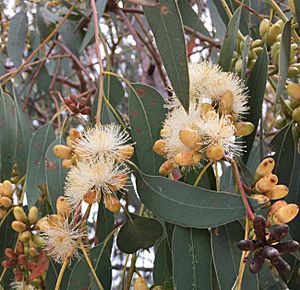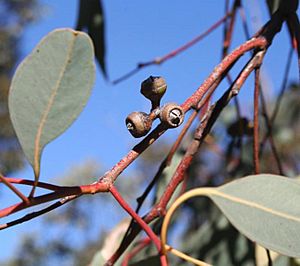Orange gum facts for kids
Quick facts for kids Orange gum |
|
|---|---|
 |
|
| buds and flowers of Eucalyptus prava | |
| Scientific classification | |
| Genus: |
Eucalyptus
|
| Species: |
prava
|
The Orange Gum (scientific name: Eucalyptus prava) is a type of tree that grows in eastern Australia. It's called "orange gum" because its bark often has cool orange and reddish-brown patches. This tree usually has smooth bark, long leaves, white flowers, and fruit shaped like a cup.
Contents
What Does the Orange Gum Look Like?
The Orange Gum is a tree that can grow up to 15 meters (about 49 feet) tall. It has smooth bark that looks mottled, meaning it has patches of grey, orange, and reddish-brown colors.
Leaves and Flowers
Young Orange Gum plants have dull bluish-green leaves shaped like an egg. These leaves are about 45 to 105 millimeters (1.8 to 4.1 inches) long and 30 to 70 millimeters (1.2 to 2.8 inches) wide. They also have a small stalk called a petiole.
Older trees have leaves that are arranged alternately along the stem. They are dull bluish or greyish-green on both sides. These leaves are shaped like a spear or are slightly curved, measuring about 55 to 160 millimeters (2.2 to 6.3 inches) long and 15 to 37 millimeters (0.6 to 1.5 inches) wide. They narrow down to a petiole that is 15 to 26 millimeters (0.6 to 1.0 inch) long.
The flower buds grow in groups of seven. They are found where the leaves meet the stem. Each group of buds is on a stalk called a peduncle, which is 8 to 20 millimeters (0.3 to 0.8 inches) long. Each individual bud has its own tiny stalk, called a pedicel, about 2 to 5 millimeters (0.08 to 0.2 inches) long.
When the buds are ready, they are oval-shaped, about 10 to 15 millimeters (0.4 to 0.6 inches) long and 4 to 6 millimeters (0.16 to 0.24 inches) wide. They have a horn-shaped or cone-shaped cap called an operculum. Orange Gums usually flower in January, and their flowers are white.
Fruit
After flowering, the tree produces woody fruits. These fruits are shaped like a cup or half a sphere. They are about 3 to 8 millimeters (0.12 to 0.31 inches) long and 5 to 10 millimeters (0.20 to 0.39 inches) wide. The parts that open to release the seeds, called valves, stick out quite a bit from the fruit.
How Did the Orange Gum Get Its Name?
The Orange Gum was first officially described in 1990 by two botanists, Lawrie Johnson and Ken Hill. They wrote about it in a science journal called Telopea. The plant material they studied was collected by Roger Coveny in 1973 near a place called Torrington.
The scientific name prava comes from a Latin word, pravus, which means "crooked." This name refers to how this tree often grows in a slightly bent or crooked way.
Where Does the Orange Gum Grow?
The Orange Gum tree likes to grow in woodlands. It usually prefers poor, rocky soils that come from granite or sandstone.
You can find this tree in eastern Australia. In New South Wales, it grows north from a town called Moonbi. In Queensland, it grows up to Wallangarra and Stanthorpe.
Is the Orange Gum Protected?
The Queensland Government has a list of plants and animals and how safe they are. The Orange Gum is classified as "least concern" under the Queensland Government's Nature Conservation Act 1992. This means that, for now, there are plenty of these trees, and they are not considered to be in danger of disappearing.


